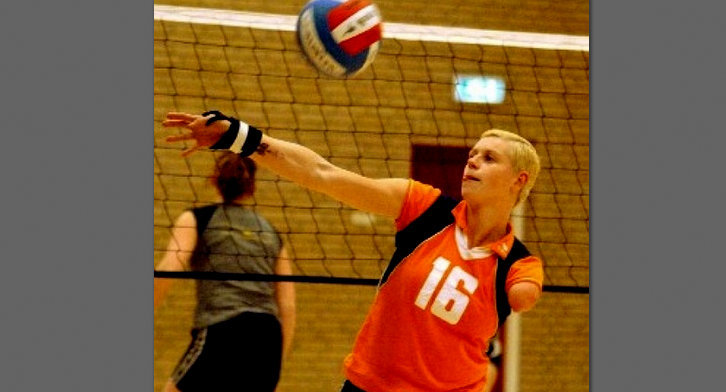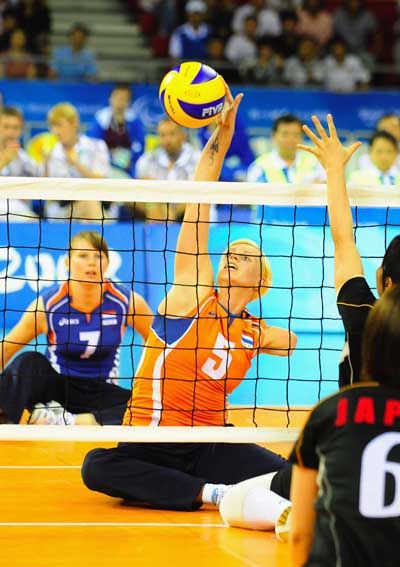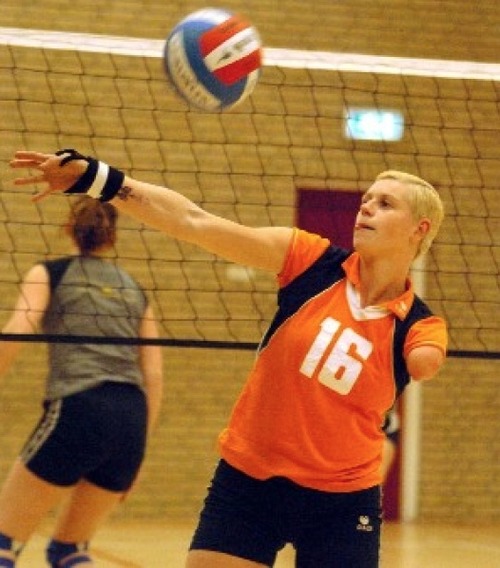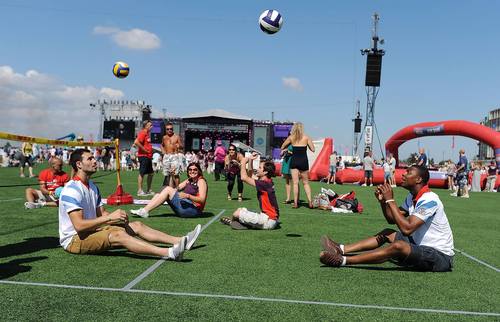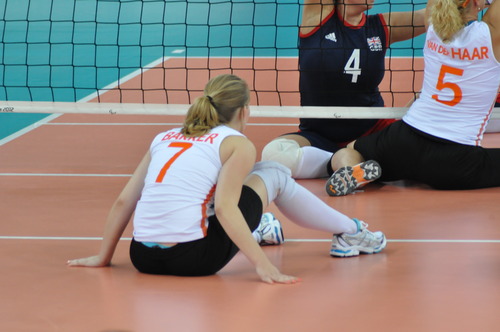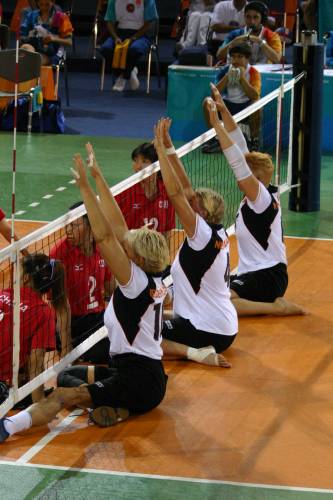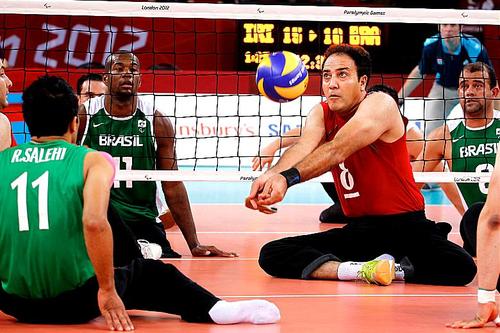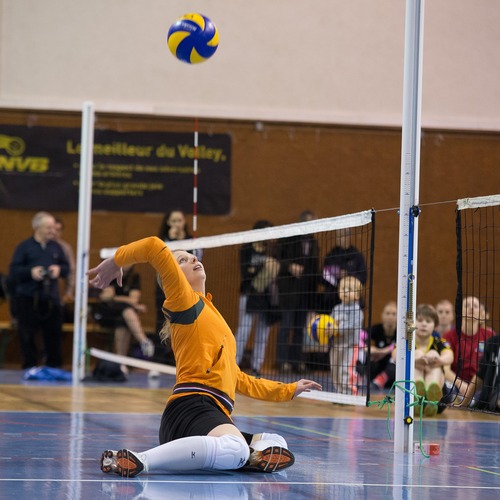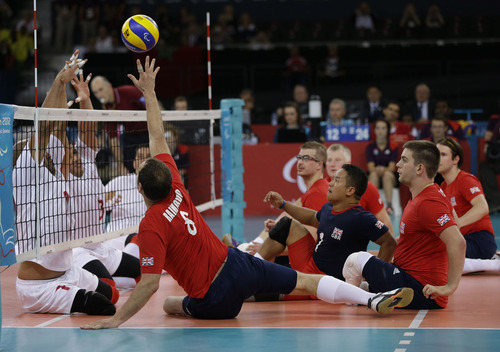Transitioning from Volleyball to Sitting Volleyball by VolleySLIDE
There are many reasons why someone may start playing Sitting Volleyball. Sometimes it is a voluntary decision or sometimes it is ‘forced’ upon them, based on their own personal circumstances changing.
The appeal of Sitting Volleyball for people with a handicap is obvious. Everyone who plays, experiences a sense of ‘freedom’, either by removing their prosthetic limb(s), or getting out of their wheel chair to compete ‘body against body’. This is fairly unique to the disability sports world. Or if it is the social aspects of sporting participation and performance that you are after, then there are also very few sports that can compete with Sitting Volleyball. As with traditional, ‘normal,’ volleyball, there are 6 players per team, on a smaller court with a lower net and what one team member does, directly influences their teammates.
However, there are some who see competing whilst being sat on the floor as being ‘dirty’ or ‘demeaning,’ but those who play don’t see it as the floor, they see it as their sporting surface or ‘stage’. Within the Paralympic Movement there have been many terms used, such as the ‘floor cleaners’ or ‘but polishers’, whilst others cannot understand why people would choose to sit and play sport when they are able to stand (with or without the support of some technological materials). However this can easily be reversed, as why would you only stand to play sport, if you can sit as well? Of course there are some who have a handicap and can play both:
The Netherlands No. 5 Karin van der Haar playing Sitting Volleyball
Karin van der Haar playing Volleyball
Of course if someone is looking for immediate international success, then an individual sport may seem more appealing. As to achieve success in Sitting Volleyball you need to have at least 5 other colleagues with the same drive, determination and performance level as yourself.
Something that we believe to be fairly unique for a Paralympic sport, is that in Sitting Volleyball at club level, a significant percentage of people play who do not have any kind of disability or handicap. While the International Paralympic Committee are focused on providing more sporting opportunities to individuals with a disability, we at VolleySLIDE are looking to present Sitting Volleyball as a sporting opportunity to anyone who wishes to play it.
To compete at the international level requires classification, however as we are finding there are many additional reasons why people end up playing Sitting Volleyball. From our experience, the most common of these are:
Someone who is born with a physical handicap and wishes to play sport.
Some acquires a physical handicap and wishes to play sport.
Someone with a long term chronic sporting injury to their lower limbs (often as a result of too much [standing] Volleyball!) who is unable to play standing up anymore.
Someone who started with Volleyball but fancies a new challenge (as it is ‘familiar’ but ‘different’).
Someone who has a family member, friend or work colleague who has a physical handicap (see video below) and wants to play/compete with them.
Someone who simply likes to support disability sport and those who play it.
There was an advert produced by Guinness recently that could just as easily been done about Sitting Volleyball:
A large percentage of people who come to Sitting Volleyball, start with the sport of Volleyball. However there is little written guidance to inform and support people through this transition. This blog is aimed at briefly explaining the differences for any player or coach coming from this route.
So what does a Volleyball PLAYER need to know when first trying Sitting Volleyball?
Firstly the rule differences from Volleyball are:
You can block the serve.
You can make contact with the opposition’s court (over the centerline), as long as you don’t interfere with their play.
Your position on the court is based on where your bum is, not your feet.
A part of your core (from buttocks to shoulders) must be in contact with the floor when you touch the ball. When a player leaves the court, this is known as ‘lifting’.
You cannot ‘take steps’ to retrieve the ball.
After considering the implications of these differences, below are some technical hints that may help players further.
If you have legs, use them to help you move. Don’t let them be an ‘anchor’ that you drag around the court. Most movements should be initiated with arms and legs, and then finished with the legs, leaving your hands free to play the ball.
In all other sports, players are taught to go towards the ball to contact it at the highest possible point. But in Sitting Volleyball players must wait for the ball to reach them or they will ‘lift’ off the floor.
With the same number of players, on a smaller court there is less chance of hitting the ball into the floor, so finishing the point is harder.
MOST IMPORTANTLY: At all times when not playing the ball, have your hands on the floor. A common problem most Volleyballers are faced with first is getting their brains to tell their hands to help move their body.
If you look at this photo of two Great Britain Volleyball Olympians playing, should they need to move to play the ball they will be too late. As by the time their hands go to the floor to move, they won’t have enough time left to prepare and actually play the ball.
How to sit:
When positioned in back court, sit in a position where you are ready to move. The most common position for this is with your legs out in front of you and your hands down on the floor. When in this position you will find that you are able to move in any direction, however moving backwards will probably easier.
The one exception to this is when defending a powerful attacking shot, as here you will have no time to move and therefore should put your legs to the side and free up the space in front of you to play the ball.
When positioned in front court, competing at the net height is important. Here more height and stability can be gained by folding both of your legs around to the same side:
However this position can also be used more generally as well:
Finally, the following should be considered when looking at the different Volleyball techniques:
Serving – Because the court is smaller, and there is a block, more thought needs to be given to serving placement and power. Try serving between the blockers or over the blockers into a space (forcing the passer to move).
Passing – Teams should line up to receive a serve in such a way that passers benefit from there being a block in front of them, not so that that are at a disadvantage by having their view hindered by sitting behind the blocking players. All players (blockers and passers) should be in a position where that can see the server contact the ball.
Try wherever possible to ‘volley’ the first contact. This is usually more accurate and can be done while rolling to the side or falling backwards, enabling you to cover more of the court.
Try not to sit with your legs folded to one side, as it is then nearly impossible to move in the direction that they are folded. Additionally, do not cross them with each other, as then it is hard to move in all directions.
Setting – The actual process of setting is fairly similar between Volleyball and Sitting Volleyball. However with attackers unable to jump, the need for accuracy is much greater. Another ‘problem’ is often when turning from blocking to setting. Therefore, make sure their legs are positioned in such a way that they can turn easily to face the court and find the ball.
Avoid having people set from the middle, as here it is nearly impossible for beginners to turn in time.
Blocking– Get your legs under the net, but be careful not to get too close to the net that you touch the top band., because as with Volleyball this is a fault. So make sure that you are close enough to penetrate the net as if you are too far away, you will not be able to block effectively.
Attacking – Make sure you develop deception and a number of different options to finish the point. With there being no jump, it is even more important to be in the right place (relative to the set) to attack effectively. Spend as much time working on ‘tipping’, ‘cutting’ or hitting off the block as you do with developing POWER!
When attacking there are two different options, and the most suitable one depends on a player’s core strength, and ultimately their personal preference over what feel comfortable.
Option 1 – Have your opposite hand up, as is trained in Volleyball, to encourage reaching to the ball.
Option 2 – Have your non hitting hand on the floor, for greater balance and stability… forcing your hitting shoulder to go up.
Jousting – With there being no jumping, there is an increased chance that the ball will get stuck between two players at the net. When this happens a let is played and the point replayed. To avoid this happening make sure you always push from the bottom up, at an angle, and not straight at the opponent, as this is their area of strength.
What does a Volleyball COACH need to know when starting with Sitting Volleyball?
Obviously the things listed above are relevant, but there are also some things that coaches should pay special attention too when transitioning to Sitting Volleyball.
General coaching tips:
Due to the smaller court, it is often easier to pick up the basics of Sitting Volleyball as a total beginner than Volleyball. However once players start to deliberately make their opponents move, that movement is much harder when sitting.
Setting up a court is easier than you think, but make sure you set the net height depending on what you are trying to achieve.
The lower the net the more contest you will have over the net.
The higher the net the longer the ralleys will be, but less attacking is possible.
The bigger the court, the easier it will be to win a point and the more players will have to move.
The smaller the court, the harder it is to finish a rally but the more likely the ball is to go out.
The gameplay is quicker with Sitting Volleyball as the ball is always closer to the floor and spends less time travelling through the air. To give the players more time you have two main options, both of which have their own positives and negatives, so we suggest using a combination of them both:
1) Allow the ball to bounce once before the player touches it
2) Use a lighter ball – so that it travels through the air slower
Remember that movement is both harder and more physically exerting. So when planning your activities or sessions make sure you don’t over work the players. Reduce unnecessary movements, for example when hitting, allow players to hit 2 or 3 balls before someone else replaces them.
Where possible, try to avoid feeding the ball in from a standing position, as the angles for the players when doing this are very different to what they will experience in a game.
Also be aware of how you communicate to the group as a whole and individuals. Try to speak in matters of fact and never make judgments or guesses about what players can or cannot do. Also be aware of the impression that is felt by the players if a coach is standing up directing them from a much higher position than those sat on the floor.
Tactical Coaching considerations:
Due to the more complex movement, the tactical system that is enforced is even more crucial. The service has a tendency to dominate a game even more than in Volleyball, so make sure for each service reception rotation you have a Plan B, Plan C and even a Plan D.
Also because of the movement challenges and the lack of time, there is much less opportunity for players to switch between their front court (or back court) positions. Therefore at some point in every game, every player will have to do every action. So try to not restrict players in training (e.g. only having Setters set), encourage all to develop all skills.
A common problem with Volleyball coaches who move to Sitting Volleyball is that that they try to use too complex systems too quickly. In order of simplicity, try the systems listed below with your players:
6-6 Here whoever is located at position 2, aims to take the 2nd touch and set.
3-6 Here there are two triangles, with players alternating. One triangle of dominant setters who occasionally attack and the other triangle of dominant attackers who occasionally set.
2-2-2 Here there are 2 players who set in 2 rotations, 2 players who set in 1 rotation, and 2 players who only set if they have to. Alternate all of these through the positions.
2-6 Here there are two dominant setters who are placed opposite each other and they each set when they are in positions 1, 2 and 3.
1-5 One dominant setter who sets each all 6 rotations, as is found at the top level of volleyball. This will rarely work in Sitting Volleyball.
Try to identify at which point the increased complexity of the system, becomes a disadvantage to the teams service reception.
Even taking all of this into account, we still haven’t touched on the biggest challenge for Coaches. Recruitment of players. For more information on this please see this VolleySLIDE blog: http://volleyslide.tumblr.com/post/41892136471/growing-the-game-recruitment-thoughts-for-sitting
The ‘hidden’ benefits of using Sitting Volleyball for Volleyball development…
There are also a number of benefits for players who try and train at Sitting Volleyball, as it actually teaches you a lot about the standing game.
Most notably:
The importance of moving into position early.
A smaller court and lower net requires the need for quicker reactions.
To help these reactions, players need to learn to ‘read’ your opponents better.
It gains players confidence in defending close to the floor (e.g. diving).
The need to develop a variety of different ways to attack and finish the point.
We hope that you have found this blog useful. Many thanks to all who contributed their thoughts. If you have any suggestions or additions to further help more people transition from Volleyball to Sitting Volleyball quicker please e-mail: volleyslide@gmail.com

